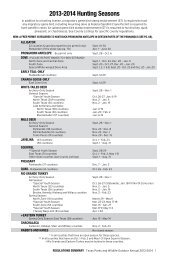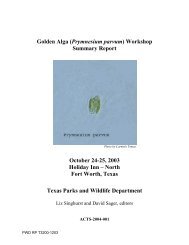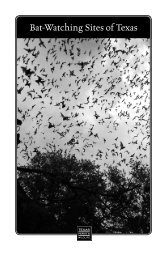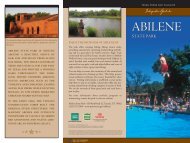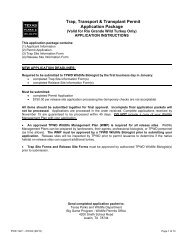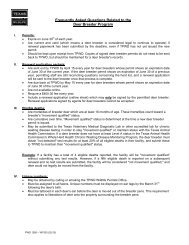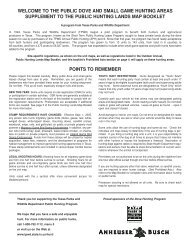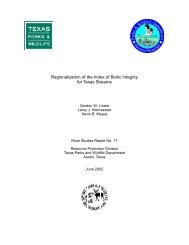White-tailed Deer Food Habits and Preferences in the Cross Timbers
White-tailed Deer Food Habits and Preferences in the Cross Timbers
White-tailed Deer Food Habits and Preferences in the Cross Timbers
Create successful ePaper yourself
Turn your PDF publications into a flip-book with our unique Google optimized e-Paper software.
Common Names: <strong>Deer</strong> vetch, <strong>Deer</strong> pea vetch,<br />
Pursh’s deer vetch<br />
Scientific Name: Lotus purshianus<br />
<strong>Deer</strong> vetch is an erect plant to 3 feet. Leaves with<br />
3 leaflets or reduced to one on <strong>the</strong> upper part of <strong>the</strong><br />
stem. Flowers are solitaire <strong>in</strong> <strong>the</strong> leaf axils with white,<br />
rosy or lavender-p<strong>in</strong>k petals. <strong>Deer</strong> vetch grows <strong>in</strong><br />
s<strong>and</strong>y soils <strong>in</strong> <strong>the</strong> <strong>Cross</strong> <strong>Timbers</strong> <strong>and</strong> Prairies Region.<br />
Seasons of Use: Spr<strong>in</strong>g, Summer, Fall<br />
Forage Class: Forb<br />
Bloom: May to July (Annual)<br />
Common Names: Eryngo, Levenworth’s eryngo<br />
Scientific Name: Eryngium leavenworthii<br />
Eryngo is a tall erect, prickly plant with s<strong>in</strong>gle or<br />
multiple stems or branches. Leaves are 1 to 2 <strong>in</strong>ches<br />
long, purplish, <strong>and</strong> deeply cut with 3 to 5 sp<strong>in</strong>y lobes<br />
<strong>and</strong> tips. Flowers are dist<strong>in</strong>ct with 1 to 1 1/4 <strong>in</strong>ch<br />
bright reddish-purple heads set <strong>in</strong> sp<strong>in</strong>y bracts <strong>and</strong><br />
composed of numerous small flowers. This is an<br />
attractive late summer <strong>and</strong> early fall plant <strong>in</strong> <strong>the</strong> <strong>Cross</strong><br />
<strong>Timbers</strong> <strong>and</strong> Prairies Region <strong>and</strong> grows <strong>in</strong> clayey<br />
fields <strong>and</strong> prairies.<br />
Seasons of Use: Summer, Fall<br />
Forage Class: Forb<br />
Bloom: July to October (Annual)<br />
Common Names: Evax, Rabbit tobacco<br />
Scientific Name: Evax sp.<br />
Evax are very small erect plants with white<br />
to gray wool-like pubescence on <strong>the</strong> leaves.<br />
Flowers are clustered <strong>in</strong> <strong>the</strong> leaf axils <strong>and</strong><br />
without ray flowers. Evax grows on s<strong>and</strong>y<br />
open woods, prairies <strong>and</strong> fields throughout<br />
<strong>the</strong> <strong>Cross</strong> <strong>Timbers</strong> <strong>and</strong> Prairies Region.<br />
Season of Use: W<strong>in</strong>ter<br />
Forage Class: Forb<br />
Bloom: April to June (Perennial)<br />
50 APPENDIX B: NATIVE FOOD PLANTS - FORBS



